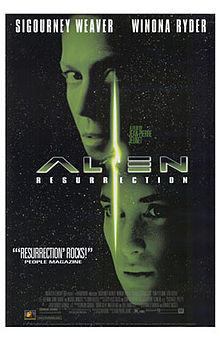200 years after the events of Alien 3, military scientists on the outer space vessel USM Auriga successfully create a clone of Ellen Ripley (Sigourney Weaver), using DNA from blood samples taken before her death. They extract from her the embryo of an Alien queen that had been growing inside her at the time of her death, and raise it to collect its eggs for further use. The Ripley clone is kept alive for further study. As a result of her DNA being mixed with the Alien's during the cloning process, she develops enhanced strength and reflexes, acidic blood, and an empathic link with the Aliens.
A group of mercenaries soon arrive in their ship, the Betty, delivering several kidnapped humans in stasis. The military scientists use them as hosts for the Aliens, raising several adult Aliens for study. The mercenaries encounter Ripley, and their youngest member, Call (Winona Ryder), recognizes her name. Call attempts to kill Ripley, believing she may be used to create more Aliens, but Call is too late; the Aliens have already matured and quickly escape their confinement, damaging the ship and killing most of its crew. Dr. Wren (J. E. Freeman), one of the ship's scientists, reveals that the Auriga's default command in an emergency situation is to return to Earth. Realizing that this will unleash the Aliens on Earth, Ripley, the mercenaries, Wren, a marine named DiStephano (Raymond Cruz), and a surviving Alien host, Purvis (Leland Orser), attempt to escape on the Betty and destroy the Auriga.
As the group makes their way through the damaged ship, several of them are killed by the Aliens. Call is revealed to be an android after Wren betrays the group. Using her abilities to interface with the damaged ship's systems, they set it on a collision course with Earth, hoping that the Aliens will be destroyed in the crash. Ripley learns that the Alien queen has gained a human ability from her DNA as well: now possessing a womb, it can give birth to live offspring without the need for eggs and human hosts. The resulting offspring, which bears a mixture of human and Alien traits, recognizes Ripley as its mother and kills the Alien queen.
Ripley and the surviving mercenaries arrive at the Betty. As they launch, the human/Alien hybrid attacks Call. Ripley kills it by using her own acidic blood to burn a hole through a viewing pane, causing the creature to be sucked violently through the small hole and into the vacuum of space. The survivors escape in the Betty as the Auriga collides into Earth.
Direction and design[]
Trainspotting director Danny Boyle was intended to direct the film. Boyle and his producer met with effects supervisors to discuss the film, although he was not interested in pursuing the project. Peter Jackson was also approached, but declined as he could not get excited about an Alien film. In 1995, after the release of The Usual Suspects, 20th Century Fox approached Bryan Singer to direct. Jean-Pierre Jeunet was asked to direct, as the film's producers believed he had a unique visual style. Jeunet had just completed the script to Amélie and was surprised he was offered the job for Alien Resurrection, as he thought the franchise had finished with Alien 3 and believed that making a sequel was a bad idea. Jeunet, however, accepted the project with a budget of $70 million. He required a translator as he did not speak much English when filming began.
Jeunet hired French special effects supervisor Pitof and cinematographer Darius Khondji, both of whom he had worked with on The City of Lost Children. Jeunet and his crew watched the latest science fiction and Alien films as reference material, and obtained production reports from the Alien films to study the camera setups. Jeunet was given creative control, contributing several elements to the script including five different endings, although the expensive ones were dismissed. He also opted to make the film a dark comedy and was encouraged to include more violence. In June 1996, conceptual artist Marc Caro had drawn rough sketches of characters' costumes, which were shown to character designer Bob Ringwood. Ringwood made several modifications for the final design, although he was not credited in the Making of Alien Resurrection book.
